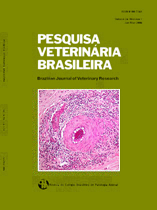 |
|
|
|
Year 2012 - Volume 32, Number 6
|

|
Clinical and laboratorial characterization of naturally infected Trypanosoma cruzi dogs in the northeastern semi-arid, 32(6):536-541
|
ABSTRACT.- Santana V.L., Souza A.P., Lima D.A.S.D., Araújo A.L., Justiniano S.V., Dantas R.P., Guedes P.M.M. & Melo M.A. 2012. [Clinical and laboratorial characterization of naturally infected Trypanosoma cruzi dogs in the northeastern semi-arid.] Caracterização clínica e laboratorial de cães naturalmente infectados com Trypanosoma cruzi no semiárido nordestino. Pesquisa Veterinária Brasileira 32(6):536-541. Unidade Acadêmica de Medicina Veterinária, Universidade Federal de Campina Grande, Av. Universitária s/n, Bairro Santa Cecília, Patos, PB 58708-110, Brazil. E-mail: almir@cstr.ufcg.edu.br
This study aimed to evidence the clinical and laboratorial signs of this disease to help characterize this illness in a natural way in the semiarid in the northeastern region. We evaluated 10 positive for Trypanosoma cruzi dogs, that were identified by serological analysis of immunofluorescence assay (RIFI) and enzyme linked immunosorbent assay (ELISA); molecular analysis by polymerase chain reaction (PCR), direct microscopy and blood culture. The chagasic dogs underwent physical examination, electrocardiographic, radiographic, blood pressure, hematology (erythrocyte and leukocyte count) and biochemical exams (urea, creatinine, ALT, AST, PT, albumin, globulin, CK, CK-MB, and cTnl). The physical examination and the blood pressure were presented within the normal range, while in the electrocardiography the FC was observed as normal with a sinus rhythm, with the exception of one dog that presented a sinus tachycardia (168 bat/min). In the ECG of eight dogs there was increase of duration of P (47+6.5ms) suggestive to atrial enlargement, not confirmed in the radiography. A supraunlevelling was observed in the ST segment in one dog. In the hematological results, thrombocytopenia (187.4x103 +137.2x103) and anemia (5.0x106 +1.39x106/ul) were noted. The mean hemoglobin (11 +2.7g/dL), hematocrit (34+10.5%) were below normal limits. The white series were within normal variation, with the exception of eosinophilia observed in three dogs. Individually, there were two dogs which registered leukocytosis, lymphocytosis and neutrophilia. In the biochemical evaluation there was hyperproteinemia PT=7.2 +0.9g/dL, hypoalbuminemia (2.2+0.4g/dL), hyperglobulinemia (5.1+1.0g/dL), increased of CK (196+171 U/L) and there was no alteration on ALT and AST enzymes. The CK-MB isoenzymes and cTnI did not change, except in three dogs. We conclude that dogs naturally infected in the northeastern semiarid present characteristics related to indeterminate chronic form (asymptomatic dogs) and that the identification of the naturally infected dogs with no pathognomonic characteristics of the Chagas disease underscores the importance of this illness in the diagnostic process with the other profiles that show nonspecific or not associated to cardiovascular disease. |
| |
|
|
| |
|
 |